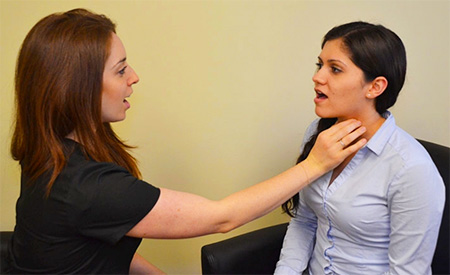A voice disorder is any deviation in pitch, intensity, resonance or quality that renders a person’s voice “abnormal” to the listener. It may be secondary to a number of underlying causes including voice overuse, neurologic disorders, trauma, surgery, cancer, viral and bacterial conditions, and psychological difficulties.
The main causes of voice disorders include vocal fold nodules, vocal fold polyps, vocal fold cysts, muscle tension dysphonia, vocal fold paralysis, reflux laryngitis, Reinke’s edema (because of smoking) spasmodic dysphonia.
Signs and Symptoms of a Voice Disorder May Include
- Hoarseness
- Breathiness
- Volume that is too loud or too soft
- Pitch that is too high or low for age
- Changes in pitch
- Voice breaks
- Loss of voice
- Vocal fatigue when speaking
- Running out of breath at the ends of sentences
- Persistent throat clearing or coughing
- A sore throat
- Acid taste in the mouth
- Difficulty swallowing
- Tension in the neck and jaw

Voice disorder treatment may include medication, surgery, voice therapy or a combination of these. The goal of voice therapy is to learn new/better patterns and ways of voice production and to eliminate poor vocal habits.
Components of a voice therapy program often include:
- Vocal hygiene (ensuring proper hydration, reducing or eliminating caffeine, managing reflux)
- Identifying and eliminating vocal misuse
- Learning appropriate breathing patterns
- Relaxation of the head and neck muscles
- Vocal relaxation
- Vocal exercises to balance and strengthen the vocal folds
The ultimate goal of voice therapy is to have the client achieve his or her best voice following injury or surgery.
In some cases, vocal therapy is done before and after surgeries.
